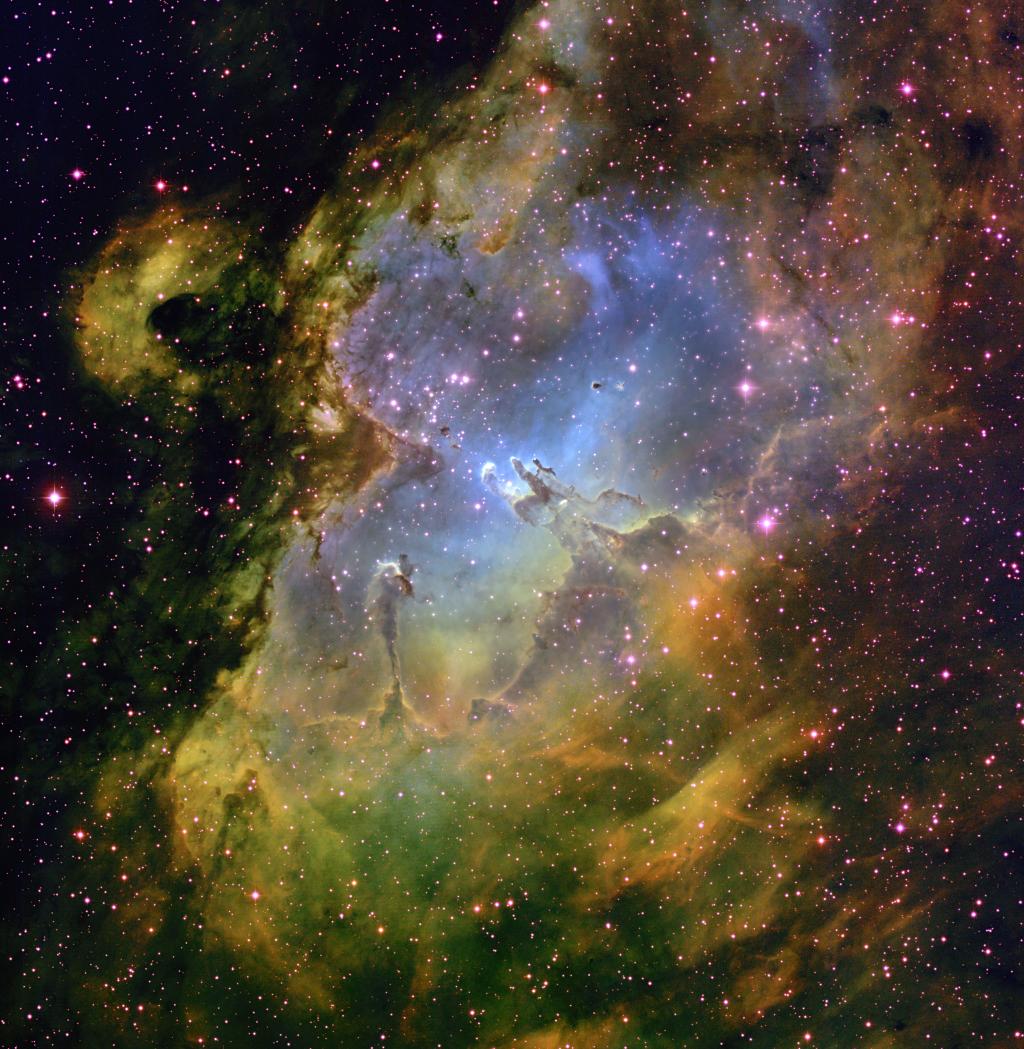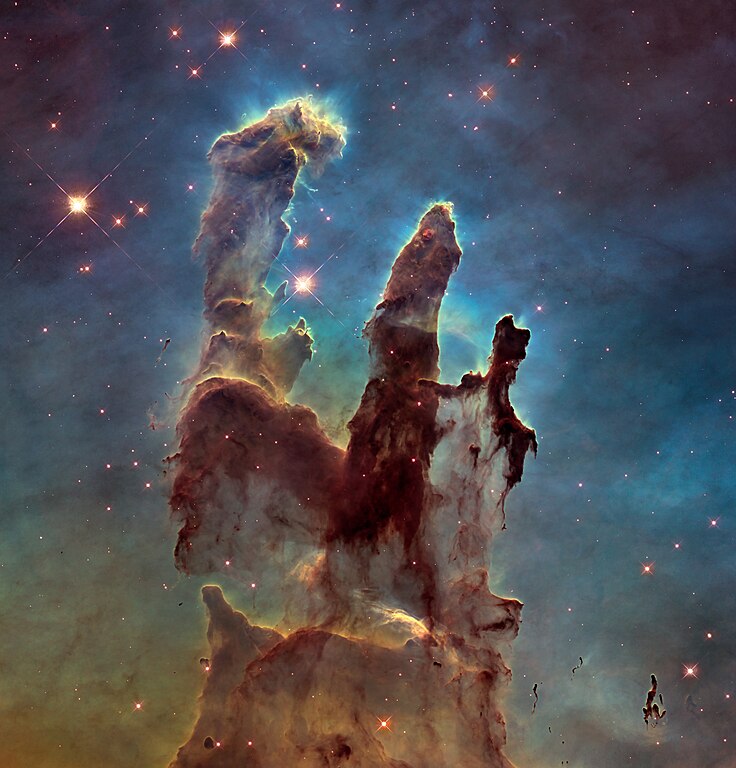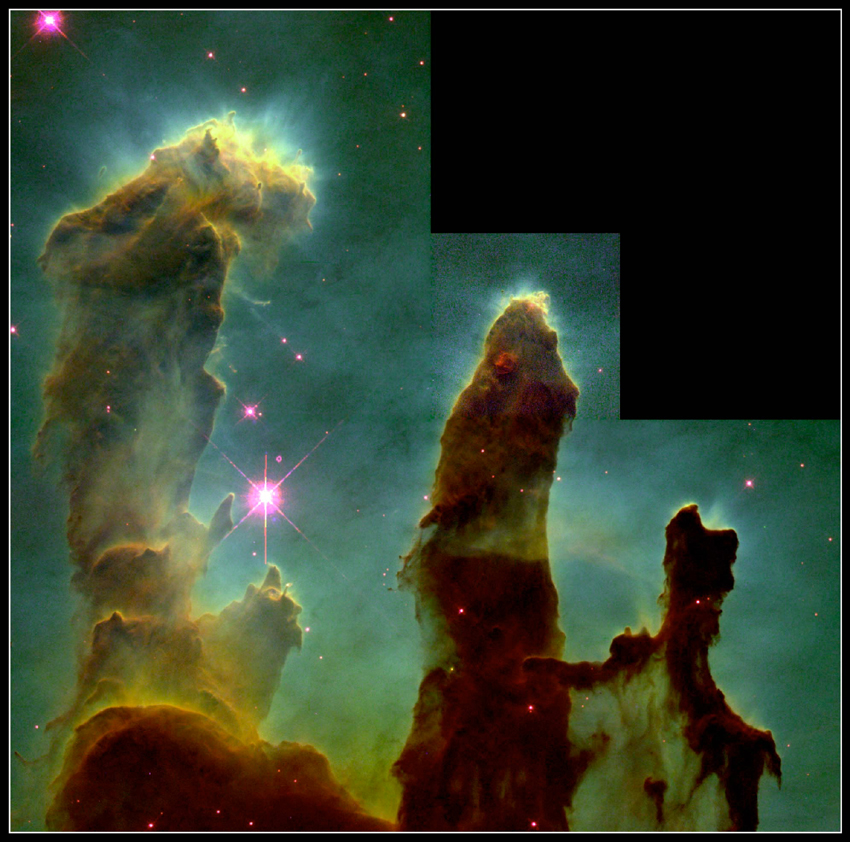
Image 1 Caption: The Eagle Nebula (M16, NGC 6611) from Kitt Peak National Observatory, Kitt Peak, Arizona.
Features:
- The Eagle Nebula (M16, NGC 6611) is
a large star forming region
in constellation
Serpens at
distance 1.740(130) kpc (5,700(400) ly).
- It is called the
Eagle Nebula (M16, NGC 6611)
because someone thought it looked like an eagle---and
NOT
because it is in
constellation
Aquila
which it is NOT.
- The image is a mosaic in false color from
emission line images:
Hα
(green),
oxygen [O III]
(blue),
sulfur [S II]
(red).
Hα
should be
red/pink
and maybe [O III] should be green to be
true color
- The 3
Pillars of Creation
from the famous
Hubble Space Telescope (HST) image
are in the center.
- Note that one has bright emission gas clouds heated by newly
formed OB stars that are evaporating the
interstellar dust,
in the dark dusty clouds where
star formation continues.
- Without some sky map,
it's hard to tell which stars are
OB stars
in the Eagle Nebula (M16, NGC 6611)
and which are foreground stars
which are bright because they
are relatively close to us.
- The group of bright stars that the
Pillars of Creation are pointing
to are probably OB stars
in the Eagle Nebula (M16, NGC 6611)
because they are a dense group associated with
Eagle nebula---this is
unlikely to be an accident.
- Image 2 Caption: The 3 pillars of dust-laden gas in the Eagle nebula (M16) from Hubble Space Telescope (HST, 1990--c.2040) in 1995---the pillars are somewhat extravagantly called the Pillars of Creation.
- Image 2 is false color. Red shows emission from singly-ionized sulfur (S) atoms. Green shows emission from hydrogen (i.e., mainly the red atomic hydrogen Hα line) Blue shows light emitted by doubly-ionized oxygen atoms.
- The pillars are protruberances from a molecular cloud that is mainly below them in the image. The tallest is about 1 lyr long.
- Above the pillars and off Image 2 are OB stars that formed at an earlier epoch of star formation. Those young stars emit ultraviolet (UV) radiation that is evaporating the pillars.
- The pillars contain small DENSE CORES or protostar or very young stars contained in dangling globules from the pillars. The stars that will appear when the dust and gas globules are evaporated.
Near the lower left of the center region there is a dangling globule that appears to have newborn star emerging.

- Image 3 Caption: "NASA's's Hubble Space Telescope (HST) has revisited the famous Pillars of Creation, originally photographed in 1995, revealing a sharper and wider view of the structures in this image in visible band (fiducial range 0.4--0.7 μm). Astronomers combined several HST exposures to assemble the wider field of view (FOV). The towering pillars are about 5 light-years (lyr) tall. The dark, finger-like feature at bottom right may be a smaller version of the giant pillars. The new image (i.e., Image 3) was taken with the HST's versatile and sharp-eyed Wide Field Camera 3.
The Pillars of Creation are bathed in the blistering ultraviolet light (ultraviolet band (fiducial range 0.01--0.4 μm)) from a grouping of young, massive stars located off the top of the image. Streamers of gas can be seen bleeding off the pillars as the intense electromagnetic radiation (EMR) heats and evaporates them into space. Denser regions of the pillars are shadowing material beneath them from the powerful EMR. Stars are being born deep inside the pillars, which are made of cold neutral molecular hydrogen gas laced with interstellar dust. The pillars are part of a small region of the Eagle Nebula (M16, NGC 6611), a vast star forming region 1.740(13) kpc (5700(400) lyr) from Earth.
The colors in Image 2 highlight emission from several chemical elements: oxygen emission is blue, sulfur is orange, and hydrogen and nitrogen are green. Note Image 2 is somewhat false color.
A number of Herbig-Haro object jets lengthened noticeably in the 19-year interval between Image 2 and Image 3."
(Somewhat edited.)

- Image 4 Caption: "The Pillars of Creation are set off in a kaleidoscope of color in NASA's James Webb Space Telescope's (JWST, 2021--2041?) image in the near-infrared (NIR, fiducial range 0.750--1.4 μm)." (Somewhat edited.)
new view of the Pillars of Creation will help astronomers revamp models of star formation. By identifying far more precise star populations, along with the quantities of gas and interstellar dust in the Eagle Nebula (M16, NGC 6611), they will begin to build a clearer understanding of how stars form and burst out of star formation regions over millions of years." (Somewhat edited).Features
- Note the colors
are false color
since this is an image from
near-infrared (NIR,
fiducial range 0.750--1.4 μm).
However, the colors have probably
been chosen in some cases to be what the
human eye
would see in the visible band (fiducial range 0.4--0.7 μm).
- The
stars and
protostars are
NOT resolved
and are overexposed,
and so have diffraction patterns.
The diffraction patterns
have 6 bright points due to the
6-fold
symmetry of
the JWST (2021--2041?)
primary
mirror
(see File:JWST spacecraft model 3.png
image).
However, often 2 weaker points are
seen especially when Image 4 is magnified.
Click on Image 4 and then on the linked image and magnify to see the extra
2 weaker points.
Some other symmetry
in the
optical system
must cause them.
- "The pillars look like
natural arches
and hoodoos (rock spires)
rising out of a desert
landscape,
but are filled with semi-transparent gas
and interstellar dust and are ever changing.
They constitute a star formation region
where young stars are forming
or have barely burst from their dusty cocoons as they continue to form."
(Somewhat edited.)
- "Newly formed stars
are the scene-stealers in
NIRCam (Near-InfraRed Camera)
Image 4."
(Somewhat edited.)
To see them click on Image 4 and then on the linked image where there is obvious red and magnify to see them. They typically have hexagonal diffraction patterns due to the 6-fold symmetry of the JWST primary mirror (see File:JWST spacecraft model 3.png image).
- "When dense regions (called dense cores) with sufficient
mass form within the
pillars,
they begin to collapse under their self-gravity,
slowly heat up, and eventually begin shining brightly."
(Somewhat edited.)
The dense cores are usually called protostars when they begin to radiate in the infrared band (fiducial range 0.7 μm -- 0.1 cm), but the term protostar is often used loosely.
After a protostar blows away its cocoon of gas and interstellar dust, it becomes a pre-main-sequence star. When a pre-main-sequence star begins hydrogen burning, it becomes a zero-age main-sequence star.
- "Along the edges of the pillars
are wavy lines that look like lava.
These are ejections from
young stars.
periodically shoot out supersonic speed
fluid jets that can interact within
clouds of material like these thick
pillars
of gas and
interstellar dust.
This sometimes also results in
bow shocks,
which can form wavy patterns like a boat
does as it moves through
water.
These young stars
are estimated to be only a few hundred thousand years old,
and will continue to form for millions of years."
(Somewhat edited.)
Yours truly does fully understand this last paragraph.
- "Although it may appear that
near-infrared light (NIR,
fiducial range 0.750--1.4 μm)
has allowed the
JWST (2021--2041?)
to pierce through the background to reveal great cosmic distances beyond the
pillars,
the interstellar medium (ISM)
stands in the way, like a drawn curtain.
This is also the reason why there are NO distant
galaxies in Image 4.
The translucent layer of gas blocks our view of
the deeper observable universe.
Plus, interstellar dust
is lit up by the collective light
from the packed party
of stars
that have burst free from the
pillars.
It's like standing in a well-lit room
looking out a window---the
interior light reflects on the
pane,
obscuring the scene outside and, in turn, illuminating the activity at the
party inside. (Somewhat edited.)
Yours truly does fully understand this last paragraph.
- "The JWST's (2021--2041?)
- Image 2 Caption: The 3 pillars of dust-laden gas in the Eagle nebula (M16) from Hubble Space Telescope (HST, 1990--c.2040) in 1995---the pillars are somewhat extravagantly called the Pillars of Creation.
-
Images:
- Credit/Permission: ©
NOAO/AURA,
T.A.Rector
(NRAO/AUI/NSF and NOAO/AURA/NSF) and B.A.Wolpa (NOAO/AURA/NSF),
before or circa 2003 /
NOAO/AURA Image Library Conditions of Use.
Download site: NOAO: The Eagle Nebula, M16.
Image link: Itself.
- Credit/Permission: NASA,
Hubble Space Telescope (HST, 1990--c.2035),
1995 /
Public domain.
Download site: Wikipedia: File:Eagle nebula pillars.jpg.
Image link: Itself.
Local file: local link: eagle_nebula_hst.html.
- Credit/Permission: NASA,
Hubble Space Telescope (HST, 1990--c.2035),
2014
(uploaded to Wikipedia
by User:Crisco,
2015) /
Public domain.
Image link: Wikipedia:File: Pillars of creation 2014 HST WFC3-UVIS full-res denoised.jpg.
- Credit/Permission: NASA,
European Space Agency (ESA),
Canadian Space Agency (CSA),
Space Telescope Science Institute (STScI),
James Webb Space Telescope
(JWST, 2021--2041?),
2022
(uploaded to Wikimedia Commons
by User:Habitator_terrae,
2022) /
Public domain.
Image link: Wikimedia Commons: File:Pillars of Creation (NIRCam Image).jpg.
File: Star formation file: eagle_nebula.html.
